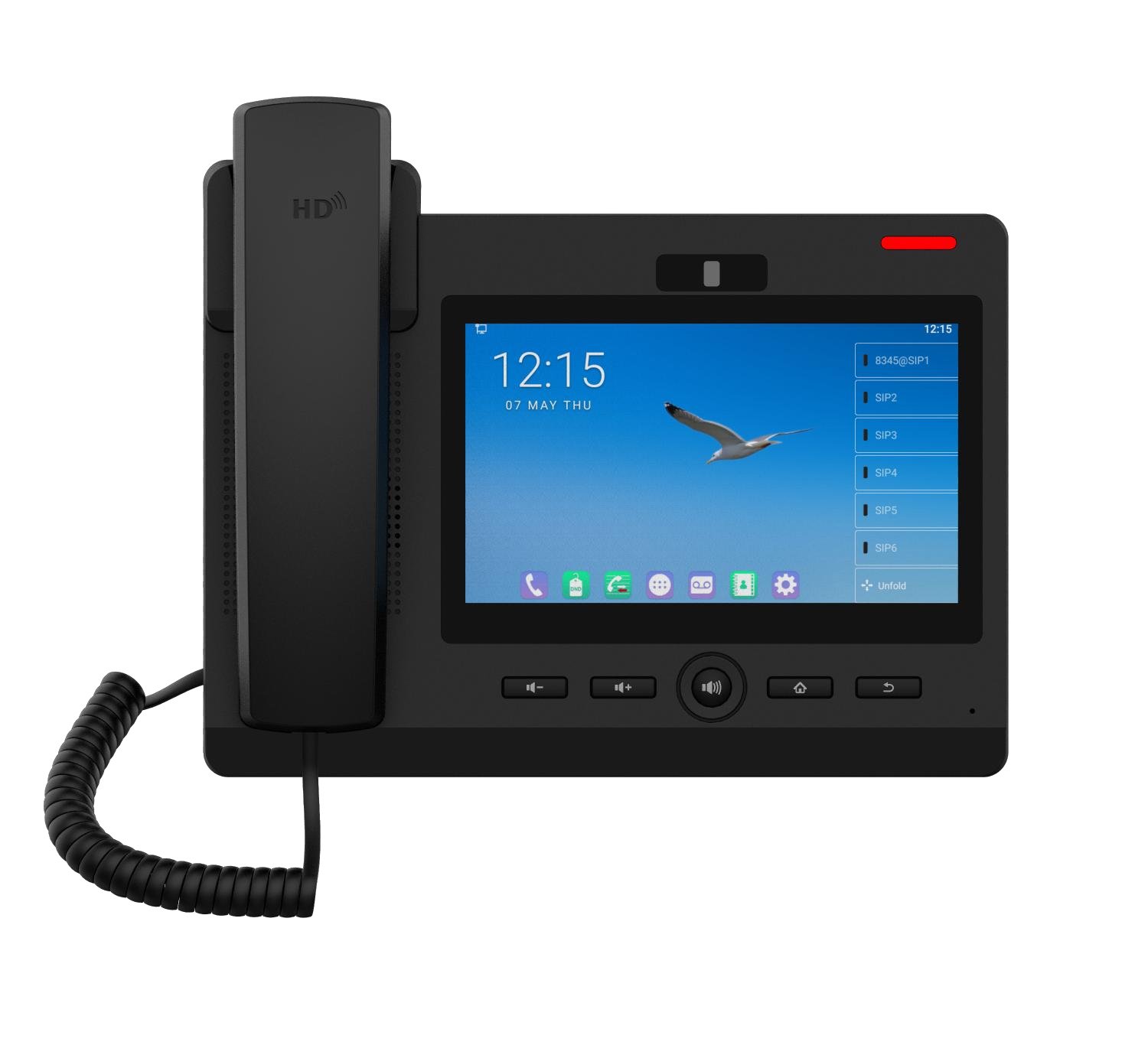Video IP Phone Introduction
- An Android IP video phone is a type of communication device that runs on the Android operating system and is specifically designed for making video calls over Internet Protocol (IP) networks. It combines the functionalities of a traditional phone with the added ability to make video calls, making it ideal for communication that involves visual interactions, such as business conferences, remote collaboration, or personal video calls with friends and family.
- An Android IP video phone typically features a touchscreen display that allows users to interact with the device using familiar Android user interface elements. It may have a built-in camera for capturing video, a microphone for audio input, and speakers for audio output. It can connect to the internet using Wi-Fi or Ethernet, and may also support additional connectivity options such as Bluetooth or cellular data.
- Android IP video phones are commonly used in business settings, where video conferencing and collaboration are important for remote meetings, presentations, and team collaboration. They can also be used in homes or personal settings for making video calls with friends and family, especially for long-distance communication. Some Android IP video phones may also come with additional features such as call recording, call forwarding, and voicemail
- Overall, an Android IP video phone offers a convenient and versatile solution for making video calls over IP networks, providing users with the ability to communicate visually and effectively in various settings.
Video IP Phone Features
- Video IP phones come with several features that enhance the user experience. Some of these features include:
High-Definition Video and Audio
- Video IP phones offer high-definition video and audio quality, making it easy for users to see and hear each other clearly during video calls. This feature ensures that users can communicate effectively, even when they are in different locations.
Built-In Camera and Microphone
- Video IP phones come with a built-in camera and microphone, eliminating the need for users to purchase external equipment. This feature makes it easy for users to set up and use the phone for video calls.
Compatibility with Multiple Software and Applications
- Video IP phones are compatible with multiple software and applications, This feature makes it easy for users to choose the software or application that best suits their needs.
Large Screen Displays
- Video IP phones come with large screen displays, which make it easy for users to see each other during video calls. This feature ensures that users can communicate effectively, even when they are in different locations.
Easy Set-Up and Configuration
- Video IP phones are easy to set up and configure, making them an ideal choice for both personal and business use. This feature ensures that users can get up and running quickly, without the need for technical expertise.
In conclusion, Video IP phones come with several features that enhance the user experience, making them an essential tool for businesses and individuals alike.
Operation System
- Android 9.0 OS with higher security and better compatibility Built-in Applications: Files, Calendar, Gallery, Browser, Email, Calculator, Notepad, Sound Recorder, Clock, Video, Music Support 3rd Party Applications Secondary Development of API。
Generic
- 20 SIP lines, SIP hotspot
- Embedded 1080P camera
- 112 one-touch DSS keys on 7” capacity color touchscreen
- HD Audio
- Support video codec H.264, for SIP video calls, RTSP video monitored. With video door phone/intercom, you can make a video preview and then open doors
- Dual Gigabit ports, integrated PoE
- Desktop and wall mounted
Video Conferencing Features
Video IP phones offer several features that make video conferencing a seamless and effective experience. Some of these features include:
- Screen Sharing: Video IP phones allow users to share their screens with other participants during video calls. This feature is useful for presentations, document sharing, and collaboration.
- Recording: Video IP phones allow users to record their video calls for future reference. This feature is useful for training, documentation, and review purposes.
- Virtual Backgrounds: Some video IP phones offer virtual background options, which allow users to choose a background image or video to use during video calls. This feature is useful for maintaining privacy or adding a professional look to video calls.
- Multi-Party Calling: Video IP phones allow for multi-party calling, which means that multiple participants can join the same video call. This feature is useful for team meetings, client calls, and remote collaboration.
- Echo Cancellation: Video IP phones are designed to cancel out any echo or feedback during video calls, ensuring that audio is clear and easy to understand.
Overall, the video conferencing features of Video IP phones make them an ideal tool for remote work, teleconferencing, and communication in general.
IP Phone features:
The Android IP video phone comes with a range of features, including:
- Local Phonebook: It can store up to 2000 entries in the local phonebook, allowing you to easily manage your contacts.
- Remote Phonebook: It supports XML/LDAP remote phonebook, allowing you to access up to 2000 entries from your server or cloud-based contacts.
- Intelligent Search: You can search through your contacts and call log using intelligent search, making it quick and easy to find the contacts you need.
- Call Logs: It keeps track of incoming, outgoing, and missed calls with a call log that can store up to 1000 entries, helping you to easily review your call history.
- Black/White List Call Filter: You can customize call filtering using black/white lists, allowing you to block or allow specific callers or numbers as per your preferences.
- Screen Saver: It supports screen saver functionality, allowing you to customize the display when the phone is idle.
- Voice Message Waiting Indication (VMWI): It provides visual or audio indicators to notify you when there are voice messages waiting in your voicemail box.
- Programmable DSS/Soft Keys: The phone comes with programmable DSS (Direct Station Selection) keys or soft keys, allowing you to customize shortcuts for frequently used features or actions.
- Network Time Synchronization: It can synchronize its time with the network time, ensuring accurate time display and call logging.
- Action URL / Active URI: It supports Action URL and Active URI, allowing you to integrate with other applications or systems for custom actions or automation.
- Distinctive Ring: You can set up distinctive ringtones for different contacts or groups, helping you to easily identify incoming calls.
- Customized Ring: It allows you to customize ringtones by choosing from a selection of built-in ringtones or uploading your own, giving you personalized call alerts.
- Audio/Video Recording: It has the capability to record audio and video during calls, allowing you to capture important conversations or video conferences.
- SIP Hotspot: It supports SIP (Session Initiation Protocol) hotspot functionality, allowing you to share your phone’s SIP account with other devices or users.
- Multicast: It supports multicast audio paging, allowing you to broadcast announcements or messages to multiple devices or users simultaneously.
These features provide a comprehensive and versatile communication solution for making video calls over IP networks, while also offering advanced functionalities for contact management, call logging, customization, and integration with other systems or applications.
An Android IP video phone also typically includes a wide range of call-related features, such as:
- Call Out/Answer/Reject: You can initiate outgoing calls, answer incoming calls, or reject incoming calls as needed.
- Mute/Unmute (Microphone): You can mute or unmute the microphone during a call to control your audio input.
- Call Hold/Resume: You can place an active call on hold and then resume the call when ready.
- Call Waiting: You can receive notifications and manage multiple incoming calls while on an active call.
- Intercom: You can use the intercom feature to communicate with other devices or users on the same network without initiating a formal call.
- Caller ID: Incoming calls display the caller’s ID information, allowing you to identify the caller.
- Speed Dial: You can set up speed dial numbers for quick and easy dialing of frequently used contacts.
- Anonymous Call (Hide Caller ID): You can choose to hide your caller ID for privacy or security reasons when making outgoing calls.
- Call Forwarding (Always/Busy/No Answer): You can configure call forwarding settings for different scenarios, such as forwarding calls when you are busy, unreachable, or for all calls.
- Call Transfer (Attended/Unattended): You can transfer calls to other extensions or numbers either with or without attending the call first.
- Call Parking/Pick-up (Depending on the server): You can park calls in designated parking spots and then pick them up from any other phone on the same server.
- Redial: You can easily redial the last dialed number for quick call repetition.
- Do-Not-Disturb: You can enable or disable the “Do-Not-Disturb” mode, which prevents incoming calls from ringing your phone.
- Auto-Answering: You can set up auto-answering for incoming calls, allowing calls to be automatically answered without manual intervention.
- Voice Message (On server): It supports voice messaging, allowing callers to leave voice messages that can be accessed and managed on the server.
- 3-way Audio Conference: You can initiate or join 3-way audio conferences with other participants.
- Hot Line/Warm Line: You can set up a hotline or warm line feature for automatic call initiation when the phone is picked up or after a predefined time.
- Direct IP Call: You can make direct IP calls to other devices or users on the same IP network without going through a SIP server.
- Hot Desking: You can log in to the phone with your personal settings and preferences when using a shared phone, allowing for personalized communication experiences.
- Busy Lamp Field (BLF): It supports the BLF feature, providing visual indications of the status of other extensions or users, such as busy, available, or offline.
These call features enhance the functionality and flexibility of the Android IP video phone, providing users with a comprehensive communication tool for managing calls, conferences, and messaging efficiently.


